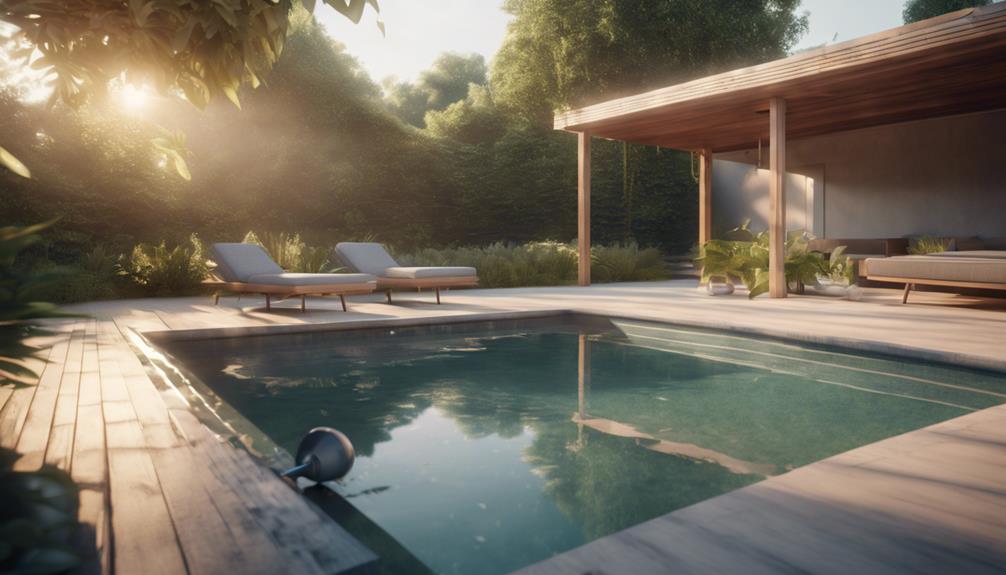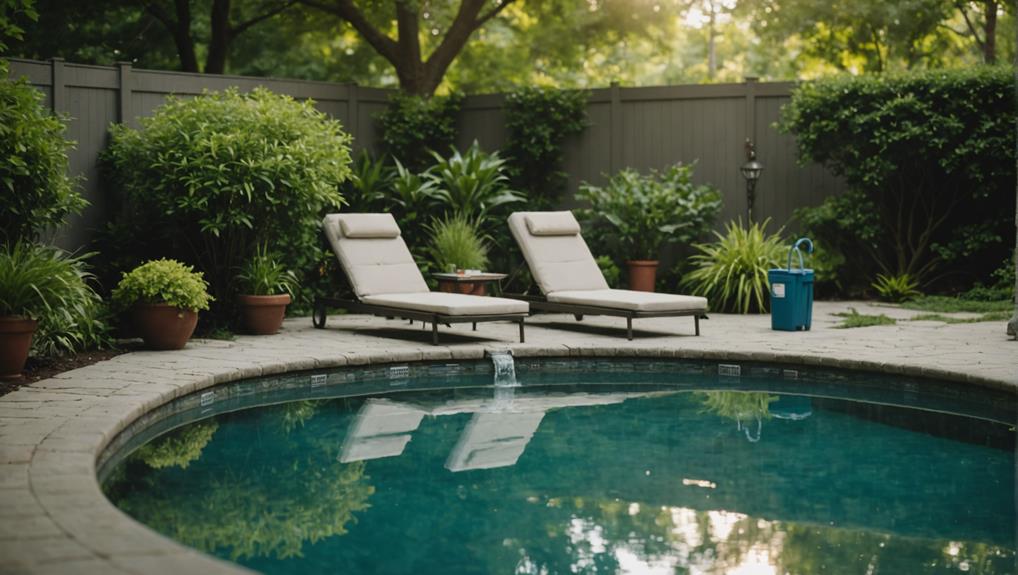When maintaining your inground pool, choosing the right algaecide is vital to prevent infestations that can lead to slippery surfaces, clogged filters, and health risks for swimmers. You'll want to ponder the type of algae, algaecide concentration, pool size, and manufacturer's instructions for effective treatment. Top algaecides for inground pool maintenance include copper-based 90-Day Algae Prevention & Remover for black algae, and McGrayel Algatec Super Algaecide for green, yellow, and black algae. By selecting the right algaecide for your pool's specific needs, you'll be well on your way to a safe and healthy swimming environment. Now, explore the best practices for applying these products to guarantee prime results.
Key Takeaways
- Choose an algaecide based on the type of algae present, such as copper-based for black algae or non-ionic surfactants for green algae.
- Consider the pool size when selecting an algaecide, as larger pools require more potent formulas or greater quantities.
- 90-Day Algae Prevention & Remover is a copper-based algaecide effective against black algae and can be used with chlorine sanitizers.
- McGrayel Algatec Super Algaecide is a highly concentrated solution that targets green, yellow, and black algae, making it a versatile option.
- Always follow the manufacturer's instructions for application frequency, dosage, and recommended usage to ensure effective algae elimination.
Types of Algaecides for Inground Pools
You have several options when it comes to choosing an algaecide for your inground pool, each with its own strengths and weaknesses.
When it comes to types of algaecides, you'll find that they can be broadly categorized into two main groups: copper-based and non-copper based.
Copper-based algaecides are effective against a wide range of algae, but they can cause staining on your pool surfaces and equipment.
Non-copper based algaecides, on the other hand, are generally safer for your equipment, but may not be as effective against certain types of algae.
Within these categories, you'll also find different formulations, such as liquid, tablet, and granular forms.
Each of these has its own advantages and disadvantages, depending on your specific pool maintenance needs.
For example, liquid algaecides are often faster-acting, while tablet forms may provide longer-lasting protection.
Understanding the different types of algaecides available is vital for effective pool maintenance and ensuring that your inground pool remains safe and healthy for swimmers.
Factors to Consider When Choosing Algaecide
When selecting an algaecide for your inground pool, you'll want to ponder several key factors to guarantee you're getting the right product for your specific needs.
You'll need to think about the type of algae you're dealing with, as different algaecides are more effective against certain types.
Additionally, you'll want to ponder the concentration of the algaecide and the size of your pool, as these factors will impact the product's effectiveness and your overall maintenance routine.
Algae Type Matters
During the algaecide selection process, it's vital to identify the specific type of algae plaguing your inground pool, as different formulas are designed to target distinct species. You wouldn't want to use a broad-spectrum algaecide that's not tailored to your pool's specific needs, as it may not effectively eliminate the algae or even exacerbate the issue.
When choosing an algaecide, consider the following factors related to algae type:
- Black algae: This type of algae is particularly stubborn and requires specialized formulas that can penetrate its protective coating.
- Green algae: Fast-growing and common, green algae can be tackled with copper-based algaecides or non-ionic surfactants.
- Yellow or mustard algae: These types of algae are often resistant to chlorine and require algaecides containing quaternary ammonium compounds or polyquaternary ammonium compounds.
Algaecide Concentration Counts
Selecting an algaecide with the right concentration is crucial, as it directly impacts the product's efficacy, potential drawbacks, and maintenance requirements.
You'll want to ponder the type of algae you're dealing with and the desired duration of treatment when choosing an algaecide concentration.
Quaternary ammonium compounds, a common type of algaecide, usually have a concentration range of 10-60%, with 30-40% being the most effective for most pool types.
However, a higher concentration may increase the risk of foaming, staining, and eye/skin irritation.
If you're battling black algae, you may need an algaecide with a higher concentration of copper, such as 7-10%.
Keep in mind that these products may require additional maintenance to remove excess copper from the water.
Always follow the manufacturer's instructions for the recommended dosage and application frequency, as excessive algaecide can cause adverse effects and reduce its overall efficacy.
Pool Size Impacts Choice
Considering your pool's size is vital in determining the right algaecide for effective algae control, as larger pools demand more potent formulas or greater quantities of the product. This is because the amount of algaecide needed varies directly with the pool size.
For instance, a 10,000-gallon pool may require 1-2 quarts of algaecide, while a 20,000-gallon pool may need 2-4 quarts, depending on the product's instructions.
The type of algae present in the pool also affects the amount of algaecide needed, with more severe cases requiring higher concentrations or more frequent applications.
When choosing an algaecide, you must consider your pool's specific needs. The frequency of use and the duration of the algaecide's effectiveness vary depending on the product and pool size. Some products may last up to 6 months, while others require weekly applications.
To guarantee effective algae prevention and removal, carefully follow the product's instructions and take into account your pool's size and type of algae. By doing so, you'll be able to select the right algaecide for your inground pool maintenance needs.
Best Algaecides for Green Algae Removal

When it comes to removing green algae from your inground pool, you'll want an algaecide that provides effective control and utilizes quaternary ammonium compounds to get the job done.
You'll find that products like In The Swim Pool Algaecide and Clorox Pool & Spa Algae Eliminator are top contenders for green algae removal, offering quick and reliable results.
Effective Algae Control
To effectively combat green algae, you'll want to reach for an algaecide that's specifically formulated to target this type of algae, such as quaternary, polymer, copper-based, or sodium bromide algaecides, each with its own strengths and limitations.
When it comes to effective algae control, choosing the right algaecide is vital.
Speed of action: Quaternary algaecides can clear up green algae up to two times faster than other types of algaecides, making them a popular choice for inground pool maintenance.
Long-term prevention: Polymer algaecides, like PolyQuat, are longer-lasting than quaternary algaecides and don't cause foaming in the water, making them a good option for controlling green algae growth and preventing future outbreaks.
Copper buildup: Copper-based algaecides, like copper sulfate, are effective against green algae, but they can build up copper in the water, leading to staining and other issues if not properly maintained.
Quaternary Ammonium Compounds
Quaternary ammonium compounds are a highly effective solution for green algae removal, as they're specifically designed to target and eliminate this type of algae.
These quat algaecides work by disrupting the cell membrane of the algae, ultimately leading to its death.
For ideal results, it's recommended to use them in conjunction with chlorine shock treatments.
When applying quaternary ammonium compounds, you can choose between liquid or tablet forms, which can be added directly to the pool water or placed in the skimmer basket for slow release.
Be sure to follow the manufacturer's instructions carefully, as overdosing can cause foaming in the pool water.
Popular quat algaecides like In The Swim Super Algaecide and Clorox Pool&Spa Algae Eliminator have been shown to be effective in removing green algae from inground pools.
With a typical dosage of 1-2 ounces per 10,000 gallons of water, you can trust quaternary ammonium compounds to get the job done.
Top Algaecides for Yellow and Black Algae
Combat yellow and black algae with confidence by selecting from the top algaecides specifically designed to target these common inground pool issues.
As a pool owner, you know how frustrating it can be to deal with algae growth in your swimming pool. That's why it's crucial to pick an algaecide that's effective against these types of algae.
Applied Biochemists Black Algaetrine: This specialized algaecide is designed specifically to target and eliminate black algae, making it a top choice for inground pool maintenance.
SeaKlear 90-Day Algae Prevention & Remover: This copper-based algaecide is effective against black algae and can be used in conjunction with chlorine sanitizers to combat yellow algae.
McGrayel Algatec Super Algaecide: This highly concentrated solution targets green, yellow, and black algae, making it a versatile option for inground pool maintenance.
When choosing an algaecide, consider the type of algae you're dealing with and the specific needs of your pool. By selecting the right algaecide, you can effectively eliminate yellow and black algae and keep your pool clean and safe for swimming.
How to Prevent Algae Growth in Pools

By implementing a few simple yet essential maintenance habits, you can effectively prevent algae growth in your inground pool and keep the water clean, clear, and safe for swimming.
| Prevention Method | Why It Works |
|---|---|
| Maintain proper chlorine levels (1-3 ppm) | Sanitizes water, kills algae spores |
| Regularly brush, vacuum, and skim | Removes dirt and debris, prevents algae growth |
| Run the pool pump for 12+ hours/day | Circulates water, prevents stagnant areas |
| Monitor and adjust pH, alkalinity, and calcium hardness | Prevents algae-preferred water conditions |
Effective Algaecide Application and Maintenance
When it comes to effectively eliminating algae blooms, applying algaecides in a targeted and regular manner becomes a vital component of your inground pool maintenance routine. You'll want to guarantee you're using the right algaecide for your specific type of swimming pool algae, as well as following the manufacturer's instructions for application.
Shock your pool first: Before applying an algaecide, shock your pool to remove any built-up contaminants and debris that may interfere with the treatment's effectiveness.
Use the right dosage: Be sure to follow the recommended dosage instructions for the algaecide, as under- or over-treating can lead to ineffective algae treatment.
Monitor and adjust: Regularly test your pool's water chemistry and adjust the algaecide application as needed to maintain ideal levels.
Frequently Asked Questions
What Is the Best Chemical to Remove Algae From a Pool?
When tackling algae growth, you'll want to ponder factors like sunlight, pH, and nutrient levels. Effective dosing and shock treatment alternatives, like oxidizers or enzymes, can help remove algae, but choosing the right algaecide for your pool's specific needs is vital.
How Often Should I Add Algaecide to My Pool?
You should add algaecide to your pool every 1-2 weeks as part of your regular schedule to prevent algae growth, following the proper dosage instructions to maintain a clear and clean pool.
What Happens if You Put Too Much Algaecide in a Pool?
"Break out the medieval 'poison' symbol, because an algaecide overdose is a real deal-breaker! You'll disrupt the delicate chemical balance, causing pool toxicity, and potentially harming swimmers – so, yeah, don't go overboard with that stuff!"
What Is the Best Way to Get Algae off the Bottom of a Pool?
You'll effectively remove algae from the bottom of your pool by combining brushing the pool floor with a stiff-bristled brush, using algae scraper tools, and employing precise pool vacuuming techniques to loosen and extract algae.
Conclusion
You've got a handle on the best algaecides for your inground pool maintenance, and now it's time to put them to work.
Remember, an ounce of prevention is worth a pound of cure – stay on top of algae growth and you'll be swimming in clear waters all season long.
Don't let algae get a foothold, or it'll be like trying to hold water in your hand – it'll slip right through.
Stay vigilant and your pool will be the epitome of sparkle and shine.

I’m Max, the founder and chief pool enthusiast behind Pool Pro Tips. As a passionate pool owner and cleaning expert, I created this website to share my knowledge and experience with you, helping you to keep your pool sparkling clean and safe for years to come.

